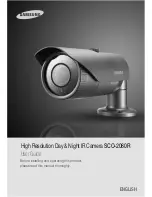
3.2 WOOD FRAME DETECTION
To locate vertical batons or wall studs, refer to the following
procedures:
Place the unit on the wall with the detection face marked “STUD”
leaning against the wall.
Turn the dial
(5)
fully downwards.
Move the selector switch to STUD DETECTOR position.
Turn the dial
(5)
upwards until the Red LED and Buzzer come on.
Reverse the dial
(5)
gently until the Green LED comes on and the
Buzzer sound disappears.
If the unit can not be set it needs to be adjusted. For details refer to
“UNIT ADJUSTMENT”.
Move the unit horizontally across the wall. Make sure that the
detection face marked with “STUD” is placed flat against the wall,
otherwise the Green LED will go out and calibration procedures need
to be repeated from the beginning.
When the edge of a batten or wall stud is under the groove of the
unit, the Red LED will come on and Buzzer will sound.
Mark this position on the wall.
Resume the movement of the unit. When the Green LED comes on
and Buzzer ceases, mark this position too.
These marks indicate the edges of the batten or wall stud. The middle
point between two marks is the centre of the batten or wall stud.
Locating horizontal battens or stud braces, refer to the following
procedures.
Place the unit horizontally against the wall.
Use the same method of locating vertical battens or wall studs to
detect horizontal battens or stud braces.
Note: The stud detection can be carried out normally on wall papered
walls. However it may not function on some types of foil backed or
metallic fabric surfaces.
If by chance the unit is placed over the wall batten or stud to process
calibration, the Green LED may go off and Buzzer may cease when
the edge of batten or wall stud is under the groove of the unit, it
means that the detection may fail.
Before detecting, calibrate the unit with the required detection face
against the wall along which you want to detect. It is advisable to take
several readings along the batten or stud because a nail may change
the apparent centre position.
Frequent re-calibrations can help to avoid any false readings.
We always recommend carrying out metal/voltage detection to ensure
the detected batten or wood stud is not a pipe or cable. Please note
that some small securing screws or nails may be detected.
If there are two studs existing adjacently, the unit may not work
correctly.
3.3 MAXIMIZING ACCURACY
The sensitivity of the unit can be pin-pointed at the exact place of
pipes, cables, battens or studs. To do this sweep the unit across the
area in question, with the red light and buzzer sounding. After each
sweep, gradually adjust the knob until the red light and buzzer are no
longer activated. Gently reverse the knob before each subsequent
sweep until the red light and buzzer come on at the location of hidden
pipes/cables or battens or studs.
3.4 UNIT ADJUSTMENT
A small screwdriver is provided for this, located under the battery
compartment cover. Don’t lose it.
Warning: Any attempt to adjust the calibration must be made
with the utmost care. Once the unit has been adjusted there is
no way to return it to the factory calibrated settings.
The adjustment mechanism is extremely sensitive and only
requires a very small amount of rotation. If large adjustments are
made it is very difficult to accurately recalibrate the unit.
Warranty claims will not be accepted if the unit has been badly
adjusted by the user.
Metal/AC Voltage Detection Adjustment
Turn the Metal/Voltage sensitivity dial by ½ turn.
Place Selector Switch to AC VOLTAGE/METAL DETECTOR position.
Turn the trimmer
(12)
by using the small screwdriver.
If the Green LED is on, slowly turn the trimmer CLOCKWISE until the
Red LED and Buzzer just come on. Slowly turn back the trimmer until
the Red LED just goes off and the Buzzer ceases. Now the unit is
correctly adjusted.
If the Red LED and Buzzer come on, slowly turn the trimmer
ANTI-CLOCKWISE until the Red LED just goes off and the Buzzer
ceases. Now the unit is correctly adjusted.
Stud Detection Adjustment
Turn the STUD sensitivity dial by ½ turn.
Move Selector Switch to STUD DETECTOR position.
Hold the unit with “STUD” face against the wall.
Adjust the trimmer
(11)
for STUD DETECTOR.
If the green light is on, slowly turn the trimmer ANTI-CLOCKWISE
until the Red light and Buzzer just come on. Slowly turn back the
trimmer until the Red LED and Buzzer just turn off and the Green LED
just turns on. Now the unit is correctly adjusted.
If the Red LED and Buzzer come on, slowly turn the trimmer
CLOCKWISE until the Red LED and the Buzzer just turn off and the
Green LED just turns on. Now the unit is correctly adjusted.
(12)
3. OPERATION AND USE






















